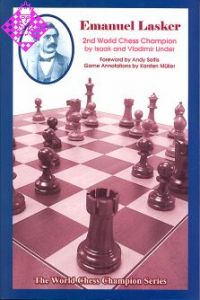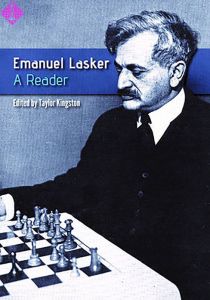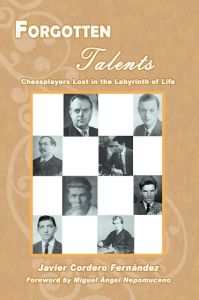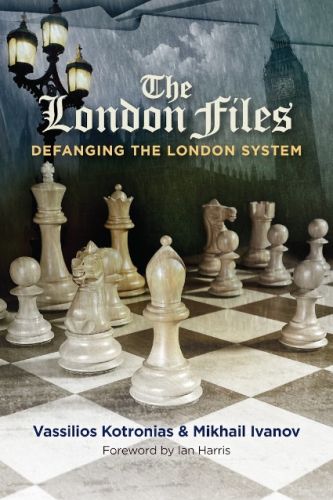Artikelnummer
LOKOTTLF
The London Files
Defanging the London System
272 Seiten, kartoniert, Russell Enterprises, 1. Auflage 2023
Although the London System was first played almost 200 years ago, it lay dormant until the beginning of the 21st century. Then chessplayers rediscovered it, realizing that the London could be played against most responses by Black, obtaining a good game with little preparation.
Nowadays the London has evolved into an opening taken up by both club players and world champions. Magnus Carlsen has played it regularly and the new word champion Ding Liren used it to convincingly defeat Ian Nepomniachtchi in game six of their 2023 title match.
Literature on the London has focused primarily on play from White’s side. However, this new book by grandmasters Vassilios Kotronias and Mikhail Ivanov changes all that. Thea authors present four (!) separate ways to combat the London: (1) King’s Indian Setups; (2) the London Benoni; (3) the London Nimzo- and Queen’s Indian; and (4) the London Orthodox System.
The London Files presents Black many good and flexible options for neutralizing White, while also giving us Londoners many new problems to contend with ... Without a doubt, this book will give Black players highly effective means to deal with the London System for a long time to come and may even have players completely rethinking their approach with the white pieces. From the Foreword by Ian Harris
Defang the London System and fear it no more!
About the Authors:
Greek Grandmaster Vassilios Kotronias, has won the championship of Greece ten times and has represented his country many times in team competitions. He is one of the most respected opening analysts in the world today.
Russian-Serbian Grandmaster Mikhail Ivanov has been successful in many European tournaments, including the 2002 Neckar Open. He is a venerable chess coach and trainer. This is his first book for Russell Enterprises.
Nowadays the London has evolved into an opening taken up by both club players and world champions. Magnus Carlsen has played it regularly and the new word champion Ding Liren used it to convincingly defeat Ian Nepomniachtchi in game six of their 2023 title match.
Literature on the London has focused primarily on play from White’s side. However, this new book by grandmasters Vassilios Kotronias and Mikhail Ivanov changes all that. Thea authors present four (!) separate ways to combat the London: (1) King’s Indian Setups; (2) the London Benoni; (3) the London Nimzo- and Queen’s Indian; and (4) the London Orthodox System.
The London Files presents Black many good and flexible options for neutralizing White, while also giving us Londoners many new problems to contend with ... Without a doubt, this book will give Black players highly effective means to deal with the London System for a long time to come and may even have players completely rethinking their approach with the white pieces. From the Foreword by Ian Harris
Defang the London System and fear it no more!
About the Authors:
Greek Grandmaster Vassilios Kotronias, has won the championship of Greece ten times and has represented his country many times in team competitions. He is one of the most respected opening analysts in the world today.
Russian-Serbian Grandmaster Mikhail Ivanov has been successful in many European tournaments, including the 2002 Neckar Open. He is a venerable chess coach and trainer. This is his first book for Russell Enterprises.
| EAN | 9781949859690 |
|---|---|
| Gewicht | 370 g |
| Hersteller | Russell Enterprises |
| Breite | 15 cm |
| Höhe | 22,7 cm |
| Medium | Buch |
| Erscheinungsjahr | 2023 |
| Autor | Vassilios KotroniasMikhail Ivanov |
| Sprache | Englisch |
| Auflage | 1 |
| ISBN-13 | 978-1-949859-69-0 |
| Seiten | 272 |
| Einband | kartoniert |
004 Signs & Symbols
005 Introduction
007 Foreword by Ian Harris
009 QuickStarter!
Part I
King’s Indian Setups
025 Chapter 1) The 4.Nbd2 and 5.e4 Plan for White
031 Chapter 2) 4.c4 and 5.Nc3
036 Chapter 3) White Plays 4c3, 5.h3 and 6.e3
054 Chapter 4) White Plays 4.e3, 5.h3 and 6.Be2
Part II
The London Benoni
071 Chapter 5) 1.d4 Nf6 2.Bf4 c5 3.e3 Nd5
125 Chapter 6) 1.d4 Nf6 2.Bf4 c5 3.e3 Qb6
141 Chapter 7) 1.d4 Nf6 2.Bf4 c5 3.d5
Part III
The London Nimzo-Indian and Queen’s Indian
163 Chapter 8) White Does Not Play c2-c4
191 Chapter 9) White Plays c2-c4
225 Chapter 10) The London Hybrid System
Part IV
The London Orthodox System
234 Chapter 11) 1.d4 d5 2.Nf3 3.Bf4 c5
267 Index of Variations
005 Introduction
007 Foreword by Ian Harris
009 QuickStarter!
Part I
King’s Indian Setups
025 Chapter 1) The 4.Nbd2 and 5.e4 Plan for White
031 Chapter 2) 4.c4 and 5.Nc3
036 Chapter 3) White Plays 4c3, 5.h3 and 6.e3
054 Chapter 4) White Plays 4.e3, 5.h3 and 6.Be2
Part II
The London Benoni
071 Chapter 5) 1.d4 Nf6 2.Bf4 c5 3.e3 Nd5
125 Chapter 6) 1.d4 Nf6 2.Bf4 c5 3.e3 Qb6
141 Chapter 7) 1.d4 Nf6 2.Bf4 c5 3.d5
Part III
The London Nimzo-Indian and Queen’s Indian
163 Chapter 8) White Does Not Play c2-c4
191 Chapter 9) White Plays c2-c4
225 Chapter 10) The London Hybrid System
Part IV
The London Orthodox System
234 Chapter 11) 1.d4 d5 2.Nf3 3.Bf4 c5
267 Index of Variations
Mehr von Russell Enterprises
-
 Emanuel Lasker24,95 €
Emanuel Lasker24,95 € -
 Emanuel Lasker: A Reader34,50 €
Emanuel Lasker: A Reader34,50 € -
 For Friends and Colleagues27,95 €
For Friends and Colleagues27,95 € -
 Fight 1.d4 with the Tarrasch!29,95 €
Fight 1.d4 with the Tarrasch!29,95 € -
 Forgotten Talents24,95 €
Forgotten Talents24,95 € -
 For Friends and Colleagues29,95 €
For Friends and Colleagues29,95 € -
 Endgame Corner29,95 €
Endgame Corner29,95 € - Mehr von Russell Enterprises

